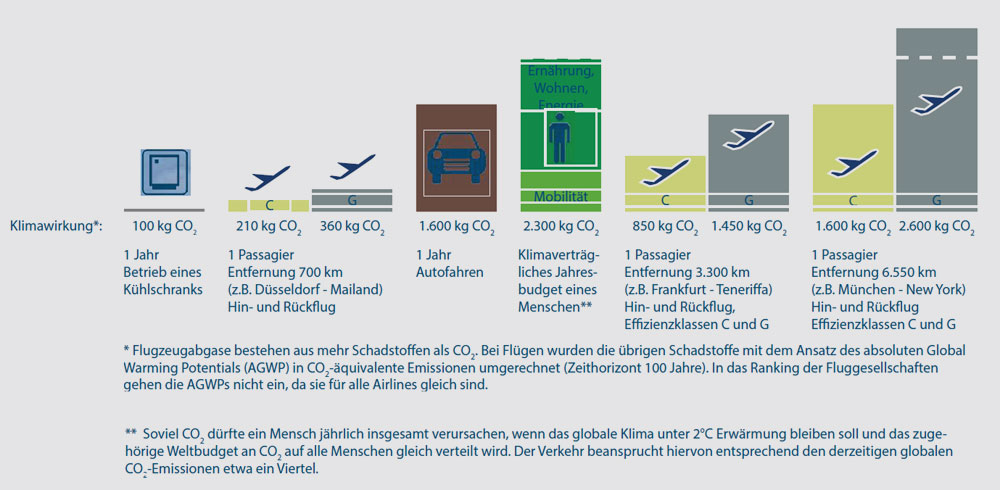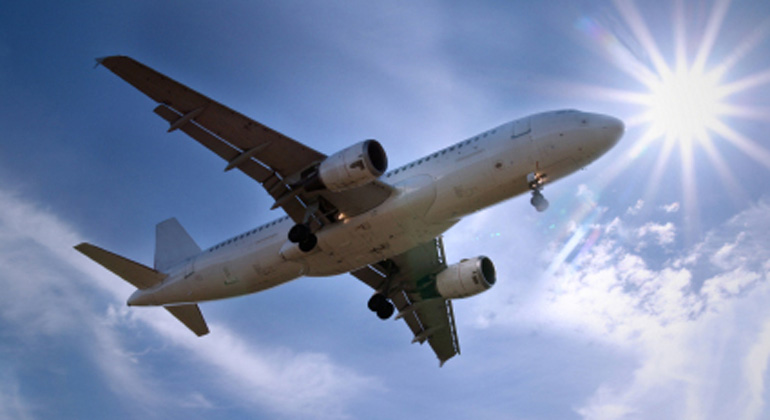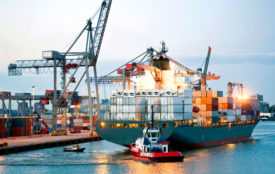Global warming and air travel
atmosfair presents the climate ranking of the world ́s largest airlines.
Worldwide one in 10 airlines manages to keep its CO2 emissions about constant despite economic growth. By increasing CO2 efficiency those airlines nearly offset their growth in flown mileage. This is a first step to reach the goals of the Paris Climate Agreement, calling for rapid and far- reaching CO2 reductions worldwide. However, the absolute carbon efficiency of these airlines is only average, showing the industries difficulty in constantly raising efficiency. These are results of the new atmosfair Airline Index (AAI) 2018, presented today.
Globally, CO2 emissions from airlines grew by five percent, while the number of kilometers flown increased by 6 percent. The necessary decoupling of traffic growth and CO2 emissions is thus not in sight. The International Civil Aviation Organization’s CORSIA Agreement will allow airlines to offset their growing CO2 emissions by means of carbon saving projects outside the aviation industry. It remains unclear how the industry itself will lower its CO2 emissions in the future to become CO2-free after 2050, in accordance with the Paris Agreement.
The AAI shows that new aircraft types such as Boeing 787-9, Airbus A350-900 or the A320neo can achieve fuel consumptions of less than 3.5 liters of kerosene per passenger and 100 kilometers, even on fuel-intensive long haul routes. These new aircraft models considerably raise the bar in terms of carbon efficiency. Airlines that have not updated their fleets or have only made slight improvements have lost ground in the current AAI ranking. As these new aircraft models do not make up for the majority of any fleet, not a single airline reaches efficiency class A, and only two airlines made it into efficiency class B (previous year: three).
Holiday airlines on top: The British TUI Airways takes first place in the atmosfair ranking as in the previous year, reaching just under 80% of the feasible optimum of low CO2 emissions. Fourth place goes to its German counterpart TUIFly. The German airline has consistently been at the top in the atmosfair ranking since 2012. With Condor another German holiday flier made it into the top 10 (72 out of 100 efficiency points).
Among the major scheduled airlines, the Chilean Brazilian LATAM leads internationally with a modern fleet and high seating capacities (second place, efficiency class B). Within the EU, the Spanish Air Europa (rank 12, class C) and KLM (rank 17, class C) follow.
China West Air ranks third in the overall standings. As a result, the regional airline is the first Chinese airline to remain permanently in the group of the best airlines (77.8 out of 100 efficiency points). Of the top 50 most efficient airlines in the world, 14 are located in Europe, 10 in China. Differences among airlines can be substantial. Fuel consumption per passenger and kilometer can be twice as high for one airline than for another on the same route. The best results are achieved by airlines that use modern aircraft ideally suited to the flight distance, have dense seating and good occupancy rates for passengers and cargo.
Low cost carriers are ranked in the AAI in a separate class. The reason: they often benefit from subsidies that allow them to offer artificially low ticket prices. This results in flight kilometers and therefore carbon emissions that otherwise would not have been produced. The best nine low cost carriers are also found in efficiency class B, but the majority ended up in efficiency classes C and D.
Structure, data and method
The Atmosfair Airline Index (AAI) individually compares greenhouse gas emissions of 190 of the largest airlines in the world and evaluates their carbon efficiency. Overall, the AAI captures about 92% of worldwide air traffic which includes 33 million flights around the globe. The current calculations are based on the latest available data on worldwide aviation from 2016. In the AAI, every airline can score between 0 and 100 efficiency points, broken down into short, medium, and long flight distances. This allows passengers to compare airlines when planning a flight and choose the airline with the lowest carbon emissions on their desired route. This is particularly interesting for companies with many business trips which, in the best case, not only reduce their carbon footprint, but also their travel costs.
The AAI is based on the carbon emissions of a given airline per kilometer and passenger on all routes flown. The carbon emissions are calculated using the aircraft type, engines, use of winglets (aerodynamic wingtips), seating and freight capacity as well as the occupancy on every single flight. The data sources only include international organizations such as ICAO and IATA and a number of specialized data services of the aviation industry as well as computer models by aircraft engineers.
International agreements
Compliance with the 2015 Paris Agreement to achieve the 1.5°C target requires that global carbon emissions reach their peak around 2020 and then begin to decrease. Air traffic is not directly regulated in the Paris agreement, while the new 2016 Montreal climate agreement of the International Civil Aviation Organization (ICAO) only takes effect gradually as of 2021.









